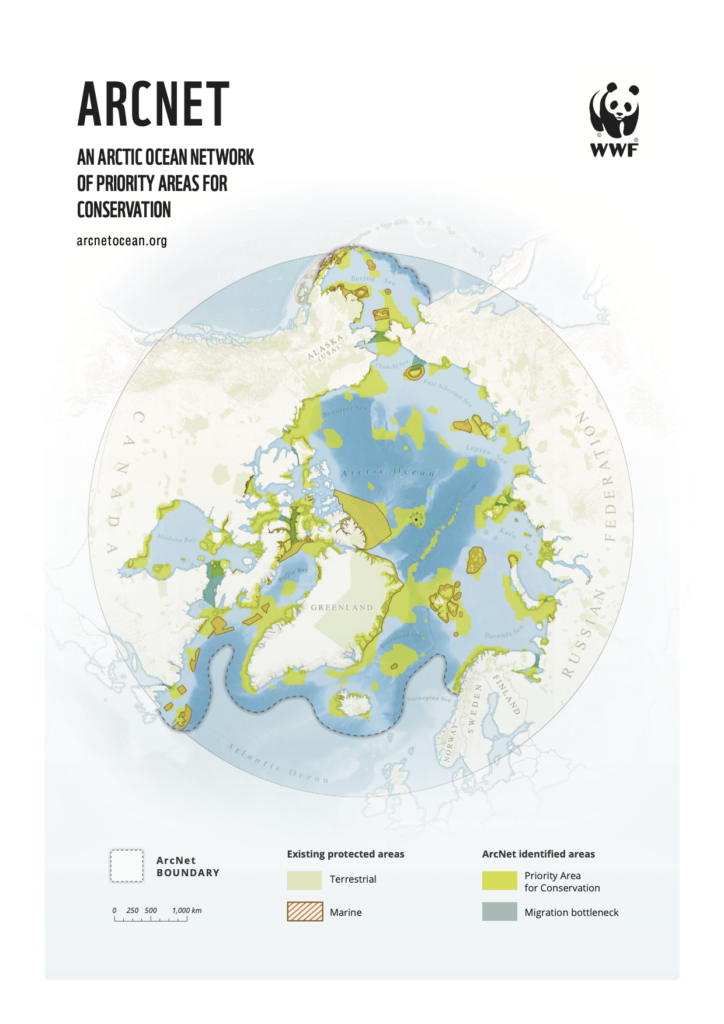© WWF
News
WWF Introduces ArcNet: A Breakthrough for Arctic Marine Conservation
- ArcNet
- Biodiversity and nature
- Communities
- Governance
[Stockholm, Sweden] – We are pleased to announce the publication of a groundbreaking scientific paper detailing the implementation of ArcNet, a transformative framework for large-scale marine conservation in the Arctic. Published in Ocean Sustainability, a new and prestigious journal within the Nature Portfolio, this paper is now available for public access, offering a timely blueprint and crucial opportunity for governments worldwide. It’s a clarion call for action, empowering decision-makers to fulfil their commitment to the UN’s Global Biodiversity Framework by safeguarding and preserving 30 per cent of the ocean by 2030.
In the face of unprecedented global biodiversity challenges, the Arctic Ocean and surrounding seas are experiencing rapid ecological shifts and increasing human activities. To address this urgent need for large-scale marine conservation, WWF proudly presents ArcNet – a whole-ocean network design and implementation pathway for Arctic marine conservation. This transformative framework maps out a network of 83 priority conservation areas covering about 5.9 million square kilometres. Its design helps to achieve implementation by providing dedicated collaboration tools to identify tailored conservation measures and adapt to new information.
ArcNet’s importance for the future of the Arctic
The Arctic’s unique ecological significance and its role as a home for Indigenous Peoples and local communities demand immediate attention. ArcNet underpins the sustainability of the Arctic Ocean for coming generations by representing the conservation needs of over 800 Arctic marine biodiversity features and contributing to ecosystem-based management of marine ecosystems.
While ambitious conservation targets have been set by nations globally, progress has been underwhelming, and the Arctic Ocean enjoys the lowest level of protection amongst the world’s oceans. The ArcNet network of 83 Priority Areas for Conservation (PACs) covers approximately 31 per cent of the Arctic Ocean, providing a timely blueprint and opportunity for governments to fulfil their commitment to the UN’s Global Biodiversity Framework to protect and conserve 30 per cent of the ocean by 2030.
Governments must act swiftly to translate commitments to protect and conserve the Arctic into action. ArcNet stands ready to bridge the gap between rhetoric and implementation, offering a vital tool to translate words into meaningful change.
— Dr. Martin Sommerkorn, Head of Conservation at the WWF Global Arctic Programme and co-author of the study
ArcNet aids cooperation to transform commitments into reality
ArcNet emphasizes a shared responsibility for conservation and charts a new approach where people with rights, stakes, knowledge, and values linked to the Arctic Ocean partner to drive knowledge-based conservation design and implementation. Without such an inclusive and equitable approach, ambitious global conservation goals will likely go unmet. Achieving them requires unprecedented cooperation at all levels of government and society, from local to international. ArcNet’s web-based tools give all partners access to its transparent scientific analysis and unique and amendable databases, thereby facilitating inclusive engagement and charting a pathway to implementation. ArcNet targets specific rights holders and stakeholders, including Arctic governments, the Arctic Council, Indigenous Peoples, marine managers, conservation professionals, scientists, local knowledge holders, and Arctic residents, seeking their involvement.
ArcNet takes a transformative approach, where inclusive engagement and unprecedented collaboration fuels implementation. Through providing a transparent analytical platform and cooperative tools, we pave the way to achieve the conservation goals the Arctic Ocean needs, from local to international levels.
— Dr. Martin Sommerkorn, Head of Conservation at the WWF Global Arctic Programme and co-author of the study
ArcNet as a blueprint for the Arctic and the world
In response to slow progress to reaching global biodiversity goals and the Arctic Council’s 2015 framework for a pan-Arctic network of marine protected areas, WWF initiated the development of ArcNet in 2017. ArcNet convened marine experts from five coastal Arctic nations for an unprecedented scientific analysis to establish a blueprint for a comprehensive network across the Arctic Ocean as the crucial first step toward broader ocean-scale conservation efforts.
In ArcNet, areas for protection and conservation are identified through an expert-driven systematic conservation planning analysis based on setting conservation targets for each of over 800 Arctic marine biodiversity features. Therefore, the ArcNet approach focuses on the ocean-scale conservation needs of marine biodiversity while also providing a pathway for broad engagement and implementation and a framework to help reconcile competing interests and achieve societal goals for both ocean conservation and sustainable use.
This design framework positions ArcNet as a model for global ocean conservation networks and for national and international collaboration to conserve and protect our ocean, including through the impending agreement on marine conservation beyond national jurisdiction, known as the High Seas Treaty.
With the conservation needs of over 800 Arctic marine biodiversity features at its core, our engagement framework ensures broad societal collaboration, paving the way for a just and sustainable future. Join in to protect our precious ocean!
— Dr. Martin Sommerkorn, Head of Conservation at the WWF Global Arctic Programme and co-author of the study
For more information:
Andrea Norgren | Sr. Manager Communications, Global Arctic Programme | andrea.norgren@wwf.se
By WWF Global Arctic Programme
